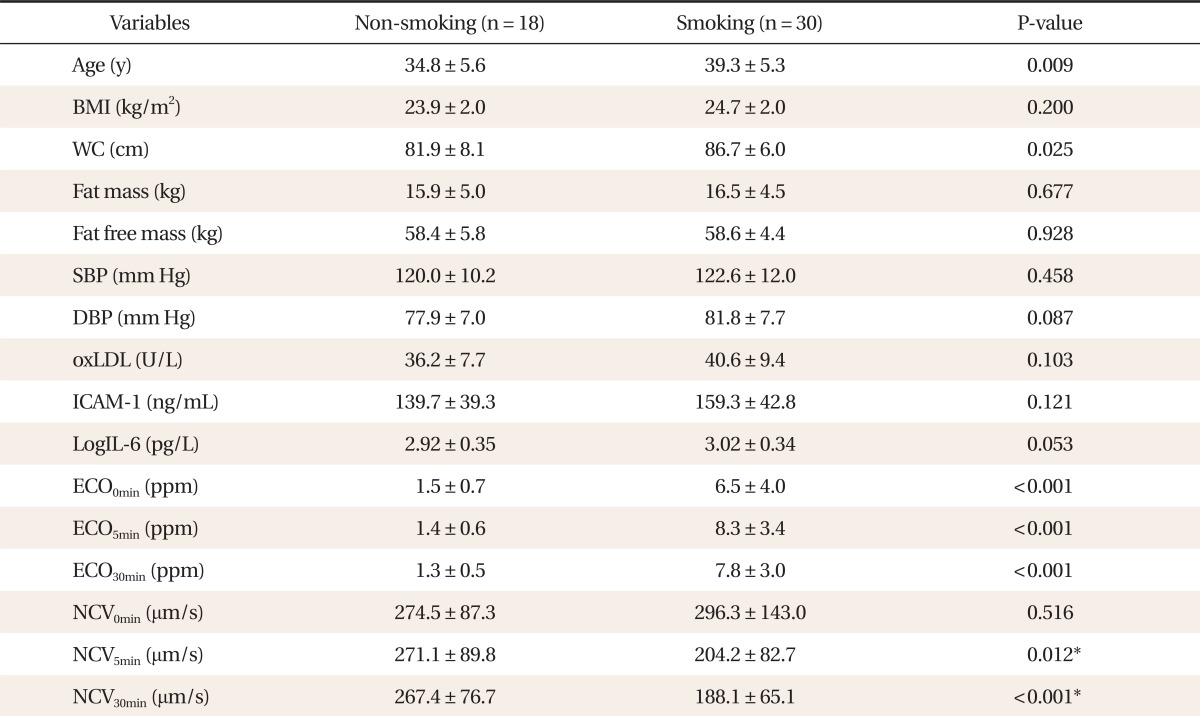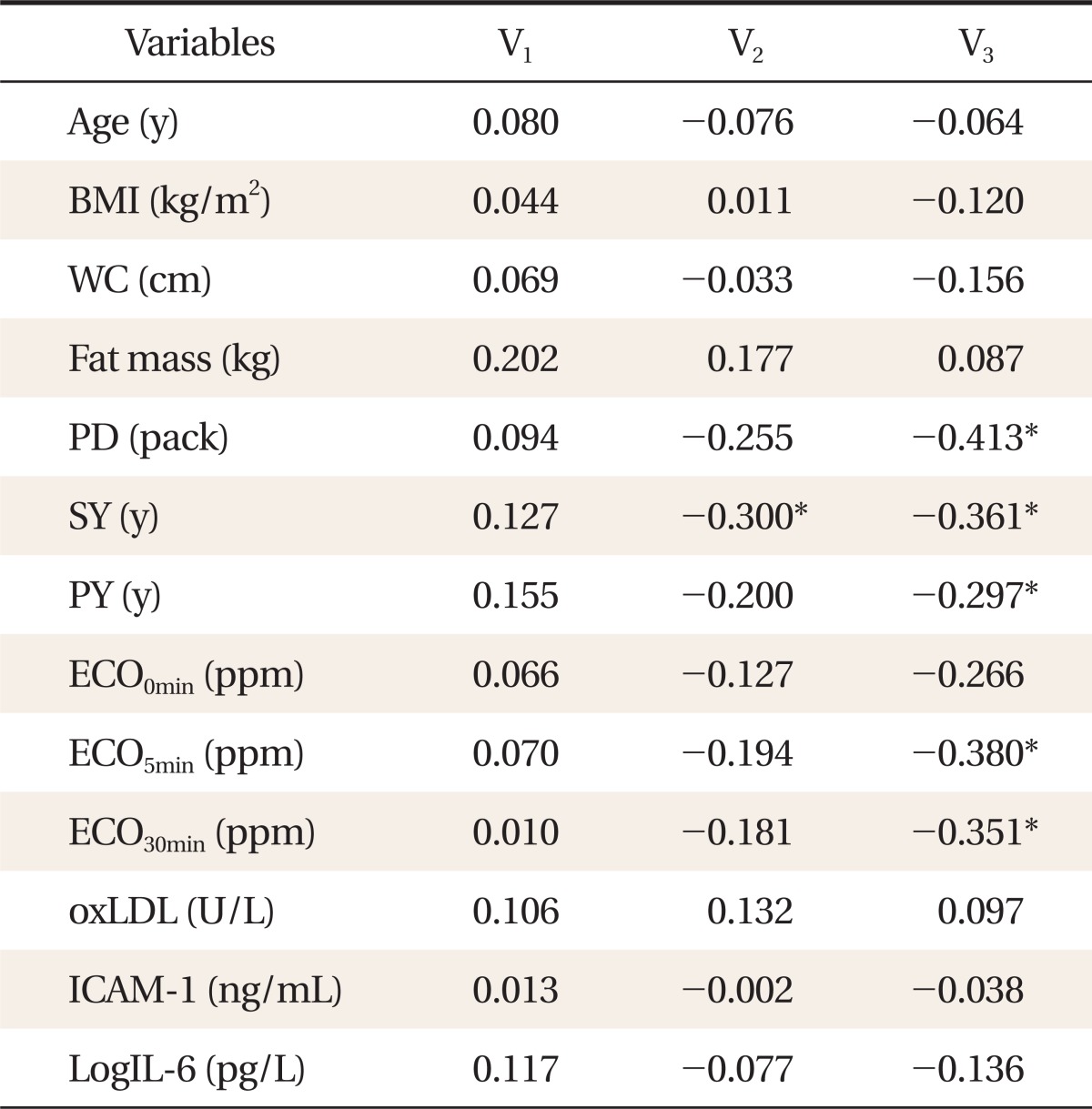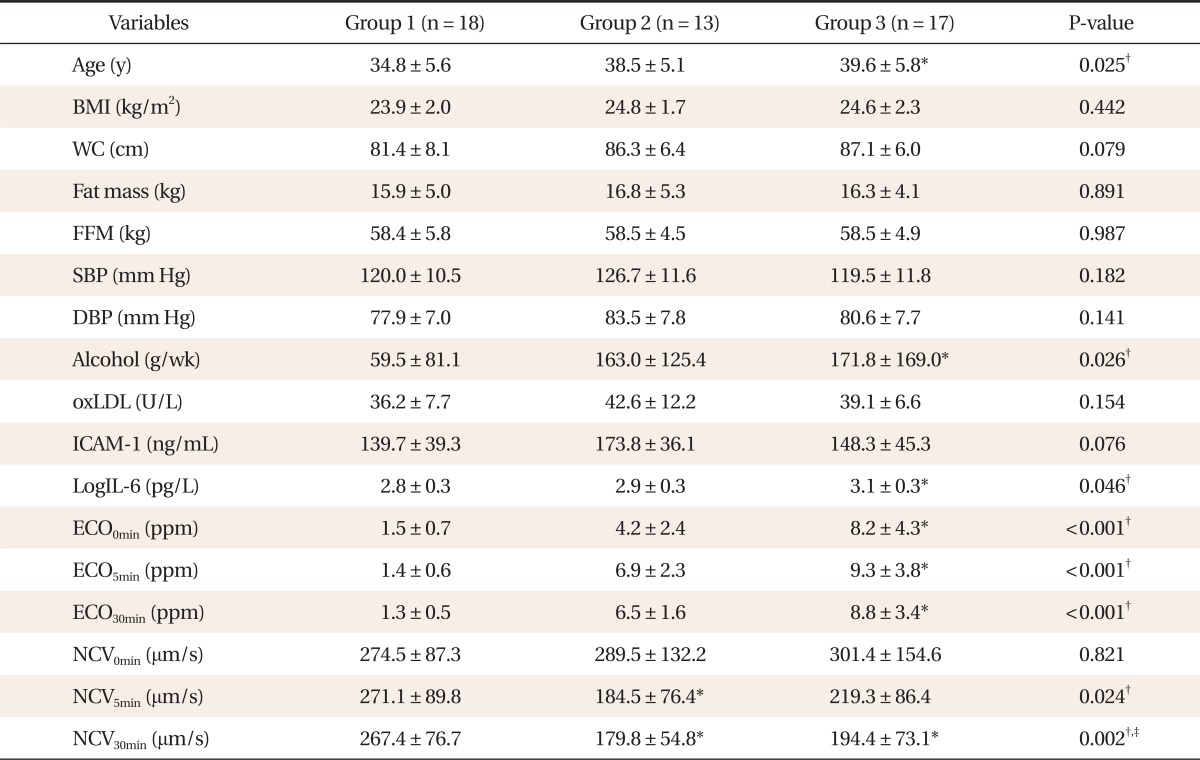 |
 |
- Search
| Korean J Fam Med > Volume 33(6); 2012 > Article |
Abstract
Background
Methods
Results
References
Table┬Ā2

Values are presented as mean ┬▒ SD. P-values were from independent t-test. BMI was calculated from body weight (kg)/height (m2). Fat mass was analyzed by bio-impedance analysis. Alcohol: average alcohol consumption in a week.
BMI: body mass index, WC: waist circumference, SBP: systolic blood pressure, DBP: diastolic blood pressure, oxLDL: oxidized low density lipoprotein, ICAM-1: inter-cellular adhesion molecule-1, IL-6: interleukin-6, ECO0min: concentration of expiratory CO before cigarette smoking detected by micro smokerlyzer, ECO5min: concentration of expiratory CO after 5 minutes of cigarette smoking detected by micro smokerlyzer, ECO30min: concentration of expiratory CO after 30 minutes cigarette smoking detected by micro smokerlyzer, NCV0min: nailfold capillary blood velocity before smoking, NCV5min: nailfold capillary blood velocity after 5 minutes of cigarette smoking, NCV30min: nailfold capillary blood velocity after 30 minutes of cigarette smoking.
*Marked on the P-values with significance after age, WC, ExpCO-1, ExpCO-2, and ExpCO-3 adjustment by analysis of covariance test.
Table┬Ā3

All values are Pearson correlation coefficients. Fat mass was analyzed by bio-impedance analysis. BMI was calculated from body weight (kg)/height (m2).
V1: nailfold capillary blood velocity before cigarette smoking, V2: nailfold capillary blood velocity after 5 minutes of cigarette smoking, V3: nailfold capillary blood velocity after 30 minutes of cigarette smoking, BMI: body mass index, WC: waist circumference, PD: average pack of the daily smoking, SY: total smoking years, PY: total pack-years calculated by PD ├Ś SY, ECO0min: concentration of expiratory CO before cigarette smoking detected by micro smokerlyzer, ECO5min: concentration of expiratory CO after 5 minutes of cigarette smoking detected by micro smokerlyzer, ECO30min: concentration of expiratory CO after 30 minutes cigarette smoking detected by micro smokerlyzer, oxLDL: oxidized low density lipoprotein, ICAM-1: inter-cellular adhesion molecule-1, IL-6: interleukin-6.
*Marked on the P-value < 0.05.
Table┬Ā4

╬▓ unstandardized coefficients, SE: standard error, NCV: nailfold capillary blood velocity, NCV5min: nailfold capillary blood velocity after 5 minutes of cigarette smoking, NCV30min: nailfold capillary blood velocity after 30 minutes of cigarette smoking, ECO5min: concentration of expiratory CO after 5 minutes of cigarette smoking detected by micro smokerlyzer, ECO30min: concentration of expiratory CO after 30 minutes cigarette smoking detected by micro smokerlyzer, PD: average pack of the daily smoking, SY: total smoking years, PY: total pack-year calculated by PD ├Ś SY.
Table┬Ā5

Values are presented as mean ┬▒ SD. P-values were from analysis of variance test. G1: non-smoking group, G2: less than 10 years of total pack-years + less than one pack of daily smoking and more than 10 years of total pack-years + less than one pack of daily smoking, G3: more than 10 years of total pack-years + more than one pack of daily smoking. BMI was calculated from body weight (kg)/height (m2). Fat mass was analyzed by bio-impedance analysis. Alcohol: average alcohol consumption in a week.
BMI: body mass index, WC: waist circumference, FFM: fat free mass by bio-impedance analysis, SBP: systolic blood pressure, DBP: diastolic blood pressure, oxLDL: oxidized low density lipoprotein, ICAM-1: inter-cellular adhesion molecule-1, IL-6: interleukin-6, ECO0min: concentration of expiratory CO before cigarette smoking detected by micro smokerlyzer, ECO5min: concentration of expiratory CO after 5 minutes of cigarette smoking detected by micro smokerlyzer, ECO30min: concentration of expiratory CO after 30 minutes cigarette smoking detected by micro smokerlyzer, NCV0min: nailfold blood velocity before smoking, NCV5min: nailfold blood velocity after 5 minutes of cigarette smoking, NCV30min: nailfold blood velocity after 30 minutes of cigarette smoking.
*Marked on the value with significance by the comparison with non-smoker in post hoc analysis. ŌĆĀMarked on the P-values with significance by post hoc analysis. ŌĆĪMarked on the P-value with significance after age, alcohol consumption, and LogIL-6 adjustment by analysis of covariance test between NCV5min and NCV30min.







